Offshore vs. Onshore: Surfing Conditions Explained

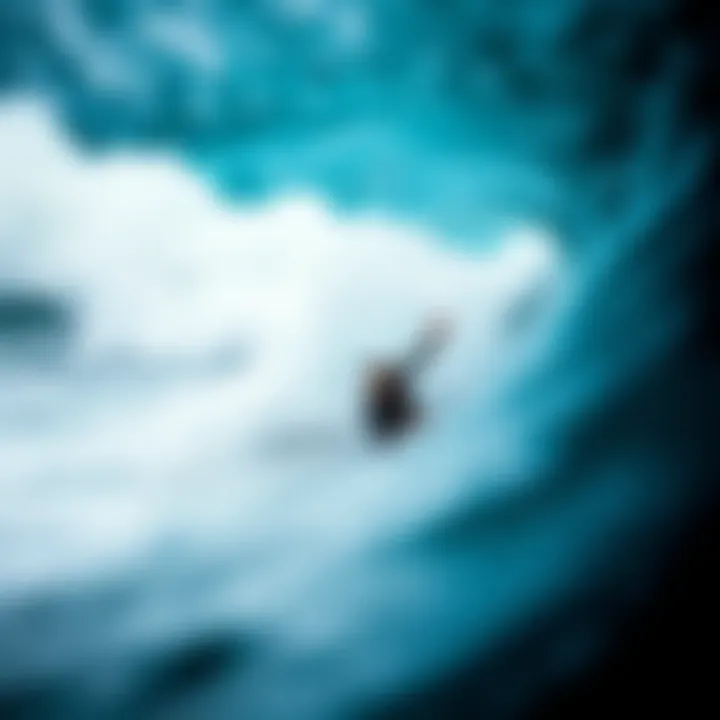
Intro
Surfing is an art form, an exhilarating interplay between wave and rider. For enthusiasts, understanding the conditions that govern each surfing experience is crucial. When we talk about surfing, the terms offshore and onshore often pop up. They might seem just like two sides of the same coin, but the variations between them can shape the quality of waves, the rider's experience, and even the weather patterns affecting the day.
In this piece, we’re piercing through the wave—peeling back the layers of what making a decision in choosing between offshore and onshore conditions entails. Whether you're planning a trip to the epic breaks of California or the more sheltered spots in Hawaii, comprehending these nuances will profoundly affect your run on the waves.
Let’s break it down.
Surfing Techniques
Understanding how offshore and onshore conditions can affect your surfing techniques is key for any surfer eager to maximize their time in the water. Different waves demand different approaches, so let’s take a closer look.
Beginner Tips for Getting Started
If you’re just dipping your toes into the surfing world, there’s a lot to take in. But when focusing on offshore vs. onshore, keep these pointers in mind:
- Wave Quality: Offshore winds typically create cleaner waves, providing a smoother ride that's ideal for beginners. Onshore winds tend to create choppy and messy conditions that can be challenging to navigate.
- Positioning: Practice positioning yourself properly. In offshore winds, set yourself up on the wave crest, while in onshore conditions, you may need to adjust your timing as the wave breaks differently.
- Safety First: Always prioritize safety. Seek out less crowded spots when learning.
Advanced Maneuvers and Tricks
For those who have traded in training wheels for a full ride, mastering techniques in both offshore and onshore conditions helps elevate your skills. Here’s how:
- Cutbacks: In offshore conditions, smooth cutbacks allow you to maintain speed and connect with the wave face. The cleaner conditions enhance control.
- Aerials: Onshore conditions can often be unpredictable, so executing aerial tricks may require more precise timing. Understanding how to read these waves can give an advantage.
- Tube Riding: Offshore days can offer epic barrels. Positioning and timing are critical to getting into the tube without getting caught.
Surfboard Selection
Your surfboard serves as an extension of yourself while riding. Whether offshore or onshore, the choice of board can mean the difference between a thrilling ride and a frustrating day at sea.
Choosing the Right Board for Your Style
Selecting a board that complements your surfing style is paramount. Consider these factors:
- Board Type: For offshore conditions, a shorter board can help you navigate faster, while an all-around board works well for onshore.
- Width and Volume: Wider boards provide stability in messy conditions, ideal for onshore waves where the chop can throw you off balance.
- Personal Comfort: Your size and skill level play a role. Pick a board that feels comfortable underfoot.
Surfboard Maintenance and Care
Regardless of the conditions you prefer, keeping your board in shape is essential. Here are some maintenance tips:
- Rinse Properly: Saltwater can be harsh on surfboards. Rinse your board with fresh water after every session.
- Check for Dings: Inspect your board regularly. Dents or cracks can worsen if left unattended, affecting performance.
- Storage: Store your board out of direct sunlight to prevent warping or fading.
Maintaining your surfboard is like taking care of your best friend—treat it well, and it'll treat you back.
As enthusiasts, weaving through the tapestry of offshore and onshore surfing conditions will inevitably lead to richer and more fulfilling experiences in the water. Whether you're a novice or a seasoned pro, arm yourself with this knowledge, and you’ll reap the rewards on every wave you ride.
For more information, consider checking resources like Wikipedia, Britannica, or join community discussions on Reddit. Engage in the conversation and share your journey!
Understanding Surf Conditions
Understanding surf conditions is paramount for any surfer. It's not just about riding the waves; it’s about knowing what those waves bring with them, and how conditions can change throughout the day. Wind patterns, water temperature, and tide fluctuations all come into play. For surfers, comprehensive knowledge of these elements can turn an average session into an exhilarating experience.
For instance, knowing when to hit the beach based on the tide can make all the difference. Some spots might be absolutely perfect on high tide while others might be better during low tide. Factors like swell direction and the overall weather plays a significant role here. When the conditions align just right, it can feel like having the whole ocean to yourself.
In summary, a solid grasp of surf conditions helps surfers make informed decisions, ensuring safety while maximizing enjoyment. Individuals can focus on their experience in the water if they’re well-prepared and understand what to expect.
Defining Offshore Conditions
Offshore conditions refer to situations where winds blow from land towards the sea. At first glance, you might think, "What’s the big whoop?" But truth be told, these winds are the unsung heroes of quality wave formation. Why? Because they help hold up the waves longer before they crash down, resulting in cleaner, more organized swells.
Picture this: You paddle out on a crisp morning, the sun just peeking over the horizon, and the offshore winds are perfectly aligned. The waves are peeling just right, and you can almost feel the thrill in the air. This kind of condition can lead to fantastic surfing experiences, drawing surfers from near and far. Conversely, if the winds shift to onshore, the waves become choppy and less forgiving.
Where you can catch these pristine offshore conditions varies across the globe. Take Maui's north shore: when the trade winds are blowing offshore, you get some remarkable rights and lefts that truly put your skills to the test. This is why understanding these dynamics is pivotal for any serious surfer.
Defining Onshore Conditions
Onshore conditions, in contrast, arise when winds blow from the ocean toward the land. While some might argue these conditions serve a purpose in bringing waves to life, they tend to have a downside. The wind tends to chop up the surface of the waves, making them irregular and more challenging to ride. It’s like trying to dance on a bumpy floor; not exactly ideal for smooth moves.
Imagine you’re all geared up and excited to surf, only to find that the once-glorious swells have been transformed into messy, disorganized waves. The chaos instigated by onshore winds can result in shorter rides and less predictable waves, making it tougher for beginners and advanced surfers alike.
However, onshore winds can have their silver lining too! They play a role in refreshing the local weather and may improve water temperatures. Yet, when it comes to surfing, most enthusiasts look for that offshore wind to propel their excitement.
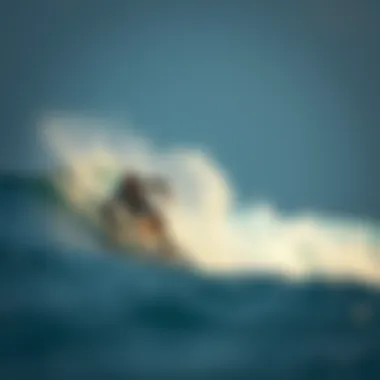
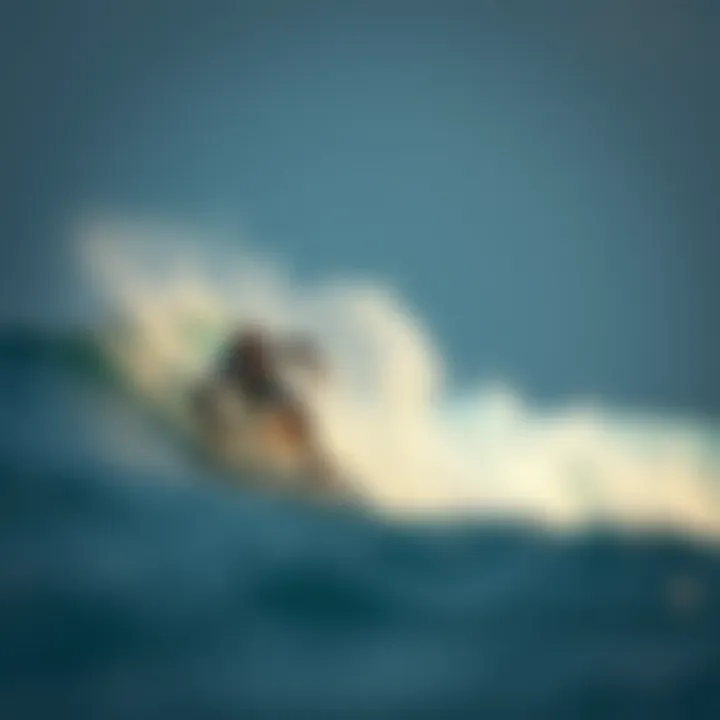
"Understanding the differences between offshore and onshore conditions is crucial for surfers looking to maximize their sessions and navigate waves effectively."
The Role of Wind in Surfing
The significance of wind in the surfing world can't be overstated. It plays a crucial role in shaping wave conditions and directly affects the entire surfing experience. Understanding how wind interacts with the ocean surface is essential for surfers looking to maximize their sessions, whether they are seasoned experts or just starting out. In this section, we will break down the differences between offshore and onshore winds, delving into how each type contributes to wave quality and overall surf conditions.
How Offshore Winds Affect Waves
Offshore winds blow from the land out to the sea, often resulting in some of the best wave conditions. These winds can groom the waves, helping them maintain shape and height as they travel toward the shoreline. The consistency created by offshore winds promotes a more organized wave formation, which can make for an exhilarating ride.
Key Characteristics of Offshore Winds:
- Wave Shape: Offshore winds push waves into a clean and defined shape, which is likely to hold up better as they break. This form leads to longer rides and smoother transitions.
- Wave Height: With the wind blowing in the direction of the wave’s travel, it allows for substantial height, especially when swells are on the rise. Surfers appreciate this, as bigger waves usually mean more thrilling challenges.
- Less Choppiness: Offshore conditions usually mean a smoother ocean surface. Less surface clutter can lead to faster paddling and easier takeoffs.
In Summary: Offshore winds create ideal conditions for surfing, offering well-shaped, powerful waves and pleasant riding experiences. A solid understanding of offshore weather patterns can truly transform how one approaches surfing.
The Impact of Onshore Winds
Onshore winds have quite a different story and create a contrasting surfing environment. Blowing from the sea toward the land, these winds tend to disrupt the wave formation, often creating choppy and inconsistent conditions. While they can foster more surfable small swells, many surfers dread strong onshore winds.
Key Characteristics of Onshore Winds:
- Disrupted Wave Formation: Onshore winds tend to
Wave Quality and Performance
Considering the impact of wave quality and performance is crucial for any surfer eager to make the most out of their time on the water. Wave quality refers to the how well a wave breaks and the overall conditions of the wave itself, while performance encompasses how effectively a surfer can ride and maneuver on those waves. Good wave quality allows surfers to practice their skills, experiment with new techniques, and simply enjoy the ride.
In general, offshore waves tend to provide cleaner faces and more powerful breaks, which can support more advanced maneuvers. On the other hand, waves formed by onshore winds often have a choppy, disorganized texture that affects rideability. By diving into the characteristics of both offshore and onshore waves, surfers can make informed decisions that maximize their overall surfing experience.
Characteristics of Offshore Waves
Offshore waves, commonly characterized by their smooth surfaces and well-defined faces, can offer surfers some of the best conditions for riding. These waves typically occur when the wind blows from the land towards the sea. Here are a few standout features of offshore waves:
- Clean Faces: Waves that come with offshore winds surface are often glassy and clean, meaning there are fewer ripples and less turbulence. This clarity allows for tighter turns, smoother rides, and more predictable breaking patterns.
- Steeper Faces: Offshore waves usually break with a sharper incline, leading to more vertical drops. Surfers often find these conditions thrilling, as they can execute powerful maneuvers.
- Longer Rides: The energy carried by offshore waves allows them to travel further, meaning surfers can often ride longer distances, maximizing their time on the water.
However, it's paramount to understand that surfing in offshore conditions often comes with its own set of challenges, such as stronger currents and more demanding take-off zones. Surfers must remain vigilant and aware of their surroundings.
Characteristics of Onshore Waves
In contrast, onshore waves are shaped by winds that blow from the sea to the shore. Unlike they’re offshore counterparts, these waves tend to have a more chaotic nature and can present several distinct characteristics:
- Choppy and Disorganized: Waves can be rough and bumpy due to the winds hitting them as they approach the shore, often resulting in a less predictable break that can challenge surfers’ abilities.
- Shorter Rides: Onshore conditions usually mean that waves break sooner, leading to shorter rides. This can be frustrating for surfers hoping for long, flat rides but also offers an opportunity to develop quick reflexes and adapt to varying conditions.
- Mellow Creatures: Despite often being less ideal for skilled surfers, sessioning onshore waves can be beneficial for beginners. The forgiving nature of these waves can help new surfers practice their paddling and stance without the fear of a steep drop.
Ultimately, the quality and performance of waves play a vital role in shaping the experiences of surfers. By recognizing how offshore and onshore waves differ, surfers can adapt their skills and choose the most suitable conditions, enhancing both their enjoyment and growth in the sport.
Weather Patterns and Their Effects
Weather patterns play a crucial role in the surfing experience, influencing everything from wave quality to the overall comfort of a session. Understanding how these patterns work can make the difference between a great day on the waves and a frustrating one. For surfers, being in tune with local weather systems means not just knowing the ideal swells but also anticipating changing conditions that can impact safety and performance.
Offshore and onshore winds manifest differently depending on weather patterns. Offshore winds, generally associated with high-pressure systems, can create cleaner, more powerful waves that are often ideal for surfing. Conversely, onshore winds, typically related to low-pressure zones, can lead to choppy and less favorable conditions.
By comprehensively analyzing weather patterns, surfers can enhance their decision-making and ultimately, their surfing experience. Such considerations include storm movements, wind directions, and temperature trends which collectively dictate surf conditions.
Understanding Offshore Weather Patterns
Offshore weather patterns tend to be more stable, especially when linked with high-pressure systems. When wind blows from land toward the sea, it generally creates optimal surfing conditions. The waves formed under these circumstances are often more organized, giving surfers the chance to ride longer and better-shaped waves.
Key Aspects of Offshore Patterns:
- Pressure Systems: High-pressure systems promote offshore winds, providing clean sets and better wave formation.
- Temperature Variations: Warmer air temperatures often accompany these systems, enhancing comfort levels.
- Weather Predictability: Conditions are generally more predictable in offshore settings, allowing surfers to plan ahead.
The beauty of these patterns is that they don't just craft quality waves; they also result in a more pleasant atmosphere—think clear skies and minimal wind interference, making for a superb surfing experience.
Understanding Onshore Weather Patterns
Onshore weather patterns are characterized by winds that blow from the ocean towards land. These winds tend to be generated by low-pressure systems, which can create challenging conditions for surfers. Waves under these circumstances often become choppy and inconsistent due to the disruptive wind, leading to a less favorable surfing environment.
Crucial Considerations for Onshore Patterns:


- Wave Quality: Choppy waves stemming from onshore winds can pose obstacles, making it harder to maintain control on the board.
- Rip Currents: Higher chances of rip currents during these conditions can increase safety risks for surfers.
- Temperature Drops: Because these systems can often bring in stormy weather, temperature drops may occur, leading to less comfortable surfing conditions.
"Understanding the whims of the weather not only keeps surfers safe but lays the groundwork for an exhilarating day on the water."
Choosing the Right Surf Spot
Choosing the right surf spot is like picking the perfect wave. It can make or break your day on the water. While some surfers might wander out with little thought about their surroundings, others understand the importance of the right location in relation to offshore and onshore conditions.
When thinking about surf spots, several key elements come into play. The most notable ones include wave quality, accessibility, safety, and crowd levels. You want to find a place that not only provides great waves but does so while keeping you safe and without battling through a crowd of fellow surfers.
Key Elements to Consider
- Wave Quality: The type and quality of waves can vary significantly based on whether the location is onshore or offshore. Offshore surf spots often provide cleaner, more powerful waves. In contrast, onshore conditions might lead to choppy and inconsistent waves.
- Accessibility: Look for a spot that's easy to reach. Not everyone has the luxury of surfing in remote locations, so proximity to where you stay matters.
- Safety: Some spots can be tricky due to currents, rocks, or other hazards. Understanding the characteristics of your chosen spot helps mitigate these risks.
- Crowd Levels: Certain surf spots are famous for their waves, but they can also attract large numbers of surfers. Finding a balance between good waves and fewer people often leads to a more enjoyable experience.
Knowing these considerations allows surfers to tailor their sessions to match their skill level and preferences. However, let's explore popular spots to help you find your next wave.
Top Offshore Surfing Locations
Offshore surf spots can feel like the holy grail for enthusiasts looking for that perfect ride. Here are a few iconic locations known for their offshore breaks:
- Jeffreys Bay, South Africa: Known for its long, right-hand point break, Jeffreys Bay takes the cake for many surfers. Its offshore winds provide pristine conditions, making it one of the top surfing destinations in the world.
- Teahupo'o, Tahiti: With its heavy waves crashing onto a shallow reef, Teahupo'o presents a challenge for seasoned surfers. But when conditions are right, it becomes an exhilarating offshore spot that attracts the best.
- Nazaré, Portugal: Renowned for its massive waves, Nazaré is not for the faint-hearted. However, the offshore winds can create stunning surf conditions, transforming the area into a surfing mecca.
- Huntington Beach, California: The famous surf city offers various breaks, with offshore conditions providing some of the best waves for both shortboarders and longboarders.
Notable Onshore Surfing Locations
Onshore spots are often just as rewarding, offering unique experiences and sometimes less crowded waves. Here are some notable locations:
- Bondi Beach, Australia: A hotspot for both tourists and local surfers, Bondi Beach sees consistent surf conditions due to its onshore winds. The atmosphere is vibrant, making it a fantastic place for surfers of all levels.
- Waikiki, Hawaii: Known for its gentle waves, Waikiki offers a prime spot for beginners to learn. The onshore winds can make it crowded, but it’s manageable, especially at sunrise or sunset.
- Pismo Beach, California: This local favorite features mellow onshore waves that are great for learners and foiling enthusiasts. It has a relaxed vibe and is perfect for a chilled day out.
- Mavericks, California: Although renowned for its big-wave surfing, onshore conditions can surprisingly create some excellent opportunities for experienced surfers looking for a thrill.
“The ocean stirs the heart, inspires the imagination, and brings eternal joy to the soul.” - Wyland
Safety Considerations
When it comes to surfing, safety isn’t just an afterthought; it needs to be at the forefront of every surfer's mind. This section compiles essential information about safety in both offshore and onshore conditions. Understanding what to look out for in each scenario can elevate not only your surfing experience but also your survival instincts in unpredictable environments.
It’s critical for surfers, regardless of their experience level, to familiarize themselves with the risks associated with various surf conditions. Let’s break down these safety considerations further.
Safety in Offshore Conditions
Surfing in offshore conditions has its perks, like cleaner waves and fantastic setups. Yet, it’s not all sunshine and surfboards. Safety should be your prime concern. Here are a few elements to keep in mind:
- Rip Currents: These currents often come with offshore conditions. They can sweep unsuspecting surfers out to deeper waters. Recognizing how to identify rip currents from the beach can be a lifesaver.
- Visibility: Early morning or late evening can create low light situations. Although the conditions may seem thrilling, decreased visibility can make it hard to spot potential hazards or other surfers.
- Weather Changes: Offshore winds can bring sudden weather changes, including storms. Monitoring the forecast is essential. A sunny morning could turn dark in the blink of an eye.
Important Tips:
*Always inform someone where you plan to surf and stick to a buddy system.
An overzealous ego can sometimes push one to surf alone. However, having a surf buddy can improve safety tremendously.*
Investing in equipment like leashes and appropriate wetsuits designed for offshore conditions can also enhance safety and ensure you are adequately prepared for the elements.
Safety in Onshore Conditions
Onshore conditions, with their gentler waves, often create a false sense of security. Yet, it’s just as crucial to adhere to safety protocols here. Below are important pointers to remember:
- Increased Surf Traffic: Onshore conditions tend to attract more surfers. This heightened activity can raise the possibility of collisions. Stay aware of your surroundings and respect others’ space on the waves.
- Shore Breaks: These waves break intensely close to the shore, which can lead to dangerous wipeouts. Be cautious of shallow waters and rocks during these surfs.
- Wildlife Cautions: Beaches teeming with onshore waves might also mean increased marine life activity. Keep an eye on your surroundings for wildlife, such as jellyfish and other creatures.
Important Tips:
- *Familiarize yourself with the beach layout and respect no-swim zones marked on local signage.
- Don’t hesitate to ask locals for advice about conditions on that day. They often know best!*
In essence, whether you're taking on offshore waves or cruising through onshore breaks, understanding the specific safety considerations mitigates risks and enhances your overall experience. Now, let’s move on to exploring how environmental factors play a significant role in shaping your surfing adventure.
Environmental Factors
When considering surfing conditions, environmental factors play a pivotal role in how both offshore and onshore conditions affect the overall experience. From wave quality to marine ecosystems, it's essential to understand how these variables interact not just for the thrill of catching waves but also for the health of our oceans. The implications of offshore and onshore activities extend beyond just the surfer; they touch upon the delicate balance of marine life, which in turn impacts the surfing experience. For surfboard enthusiasts, being knowledgeable about these factors is key for sustainable surfing and preserving the beauty of our natural playgrounds.
Impact of Offshore Activities on Marine Life
Offshore surfing locations often come with a unique set of ecological dynamics. Marine life in these areas can be both rich and diverse, thanks, in part, to the natural currents that promote nutrient cycling. However, offshore industries like drilling, shipping, and fishing can disrupt these ecosystems.
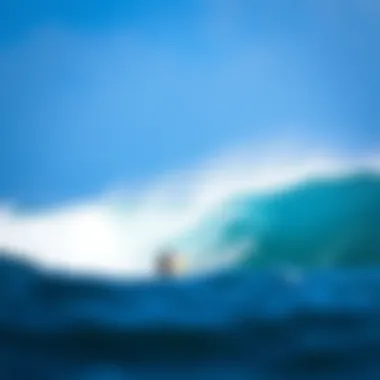
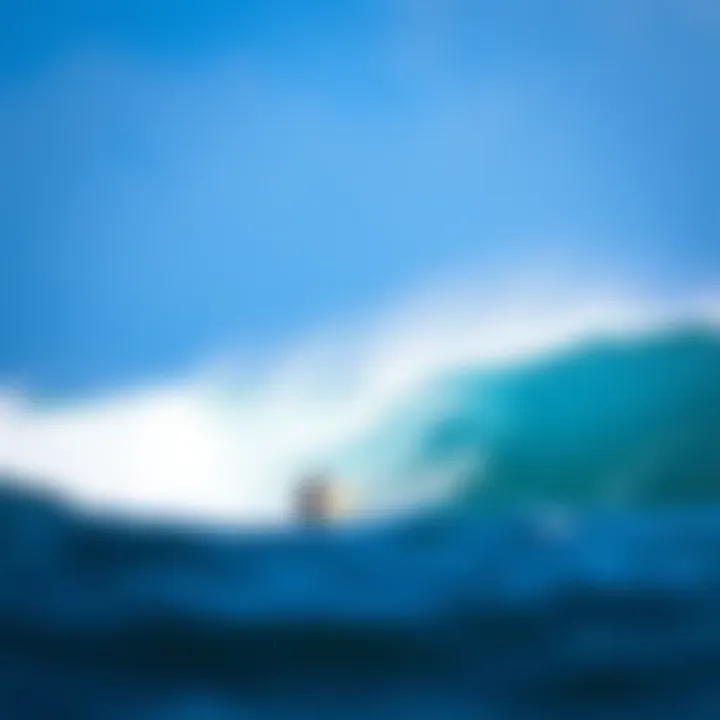
- Fishing Pressure: Increased fishing can drastically alter local marine populations. For example, if a popular offshore surf spot also happens to be a fishing hotspot, there may be a notable decline in fish species crucial for the natural food web.
- Pollution: Offshore oil spills or runoff from agricultural practices can introduce harmful substances into the water, resulting in detrimental effects on coral reefs and other sensitive habitats. In particular, the increased nutrient levels can lead to algal blooms, which may smother underwater plants and deplete oxygen levels, crucial for marine life.
Knowing these impacts allows surfers to better appreciate the need for responsible action. Supporting sustainable practices can help ensure that these ecosystems remain vibrant and teeming with life, thereby enriching the surfing experience and encouraging a harmonious relationship between humans and nature.
Impact of Onshore Activities on Marine Life
In contrast, onshore activities with a more immediate effect often stem from coastal development, pollution, and beachgoer activities. While surfing onshore waves can be accessible and exhilarating, it’s important to recognize how these human actions influence local ecosystems.
- Coastal Development: Urbanization can lead to habitat destruction. Beachfront properties and road construction often disrupt the natural landscapes vital for wildlife. This alteration can result in diminished biodiversity, affecting not just marine species but also the birds and other animals that depend on those marine life forms.
- Pollution: Runoff from streets, gardens, and industrial areas can transport chemicals and waste into the ocean during storms. This not only harms water quality but can also create 'dead zones' where aquatic life struggles to thrive.
- Beach Activities: Increase in recreational activities along the shore, such as picnicking or parties, might contribute to littering and waste. Marine animals can ingest plastics or get entangled in debris, leading to harmful outcomes.
Tips for Surfers
Understanding the nuances of surfing conditions can transform an average day at the beach into an exhilarating experience. Surfers, whether seasoned or novices, face a sea of choices when it comes to selecting the perfect wave. Knowing how to maximize offshore opportunities and make the most out of onshore sessions can significantly impact performance and enjoyment.
Maximizing Offshore Opportunities
When wind blows from the land towards the sea, it creates offshore conditions. These are often prized by surfers for several reasons:
- Wave Formation: Offshore winds help to shape and groom waves, leading to cleaner faces. This results in a more favorable riding surface, allowing surfers to carve more effectively.
- Larger Swells: Generally, offshore conditions can bring in larger swells that can lead to better overall surf quality. With the right swell direction, these conditions provide exhilarating rides and more dynamic movements on the water.
- Less Turbulence: Offshore winds reduce surface turbulence, contributing to consistent wave breaks. This can be a significant advantage for longboarders and shortboarders alike, allowing for a smoother ride.
To make the most out of offshore conditions, consider these tips:
- Choose Your Timing Wisely: Offshore winds are often more prevalent during early morning or late afternoon. Plan your surf sessions accordingly to catch the best waves.
- Know the Spots: Some surf locations are specifically known for their exceptional offshore conditions. Research your local beaches or discover new ones through online surf communities.
- Work on Paddle Strength: Offshore conditions can mean longer rides. Enhancing your paddling technique will ensure you can catch those waves and stay ahead of the game.
“Taking the time to understand your local breaks and how they respond to wind directions transforms your surfing experience.
Cultural Implications
Surfing is not merely a sport; it embodies a lifestyle, a communal identity that resonates across coastlines. The juxtaposition of offshore and onshore conditions creates distinct surfing cultures, each with unique flavors and traditions. Understanding these cultural implications is crucial for surfers who want to connect deeply with their environment while appreciating the nuances of their chosen surfing conditions.
Onshore Surf Culture
In many coastal towns, onshore surfing is often the first introduction to the waves for budding surfers. These locations are bustling with activity, as the waves are frequently ridden by enthusiasts of all backgrounds. The culture surrounding onshore surfing is vibrant and inclusive, often fostering a sense of camaraderie among surfers. Local surf shops become hubs of activity, filled with chatter about the day's surf reports and upcoming competitions. Seasonal surf events bring communities together, building a shared identity and allowing surfers to showcase their skills.
Onshore conditions can lend themselves to a more laid-back vibe. The waves might not be as pristine or powerful as offshore ones, but they offer consistency and accessibility. Many surfers can relate to this reality, creating tight-knit groups that celebrate their love for the sport, regardless of wave quality. This sense of belonging often leads to organized beach clean-ups and environmental advocacy, further fostering a community Spirit.
The sense of place is almost palpable in onshore surfing culture, with local beaches becoming second homes. Surfers develop techniques tailored for smaller, choppier waves while integrating playful maneuvers. This adaptability is a badge of honor amongst onshore surf communities, showcasing their ability to make the most of what they have.
Offshore Surf Culture
Contrastingly, offshore surfing is often characterized by a more elite perception. Conditions tend to produce larger and cleaner waves, drawing in accomplished surfers who chase the optimal performance. This allure creates a different kind of culture—one that values adventure, skill, and often, travel. Surfing offshore can take enthusiasts to breathtaking, remote locations like the reefs of Fiji or the powerful swells of Hawaii, where surfers can find themselves far from the crowds.
Offshore cultures value exploration. Surfers are willing to brave more challenging environments and weather conditions to access quality waves. The surf ethos here relies heavily on sustainability and respect for the ocean, which is viewed as a sacred place. Many join movements aiming to preserve surf spots from pollution and development, helping maintain the beauty of both the waves and the surrounding ecosystems.
Compassion within these cultures is common, with seasoned surfers often mentoring newcomers. Knowledge-sharing becomes pivotal, fostering a chain of experiences passed down through generations. Moreover, offshore communities embrace a digital presence. Surfer blogs, social media channels, and online forums allow them to connect, share experiences, and inspire one another across vast distances.
Surfers embody a spirit of adventure that transcends physical locations; it's about the quest for the perfect wave and the stories that come with each ride.
Culmination
The cultural landscapes of onshore and offshore surfing vividly illustrate the profound connection surfers have with their environment and community. Through understanding these cultural implications, one gains insight not just into surfing, but into the social fabric that binds surfers together. The nuances of these experiences elevate surfing from a mere sport to an enduring way of life.
End
As we ride the waves of this exploration into offshore and onshore surfing conditions, it's clear that understanding these nuances is not just a matter of preference; it fundamentally shapes the surfing experience. The importance of recognizing the characteristics of both types of surf cannot be overstated. Though they each present unique advantages and challenges, knowing how to adapt one’s approach can be the difference between an exhilarating session and a frustrating one.
Summarizing Key Points
To summarize the key elements discussed:
- Offshore conditions tend to create cleaner, more organized waves, often leading to high-quality surfing experiences. These conditions are favored by many seasoned surfers who are chasing perfection in their rides. However, they can also pose risks like strong currents and sudden weather changes.
- Onshore conditions, while less ideal in terms of wave quality, often provide a more accessible experience for surfers of all levels. The waves can be more forgiving, making it a safer option for beginners. The influx of wind can create challenging but fun riding conditions that are great for practicing skills.
- The weather patterns and wind directions greatly affect both types of conditions. Recognizing these patterns helps surfers choose their spots wisely, ensuring that they catch the best waves possible.
- Cultural implications also come into play; communities and local surf cultures often emerge around these different conditions, adding richness to the overall surfing experience.
By grasping these points, surfers can strategize their outings based on personal skill levels, safety considerations, and even the surrounding environmental issues that arise with surf conditions.
Final Thoughts on Offshore vs. Onshore Surfing
Surfers aiming to refine their technique might gravitate towards the cleaner, more powerful builds of offshore waves, while those seeking camaraderie and community interaction could find solace in the welcoming surf spots onshore. Both styles foster personal growth and a deeper connection with the ocean, cementing the notion that whether you prefer one over the other is secondary to the joy and understanding that surfing brings.
Ultimately, making informed decisions based on the detailed analysis of offshore and onshore conditions enables enthusiasts to ride their own waves of knowledge, setting the groundwork for rich, fulfilling experiences in the world of surfing.
"Surfing is not just a sport; it's a way of life that teaches patience and respect for nature alongside personal responsibility." - Unknown
For further reading, consider these resources:
- Wikipedia on Surfing
- Britannica's Overview on Surfing
- Reddit surfing community discussions
- Surfing safety guidelines
- Environmental impacts of surfing
Reading up on these can expand your understanding, enhancing both your surfing technique and appreciation for this dynamic sport.



